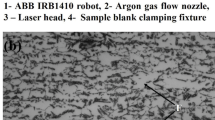Abstract
It was observed that the laser welding at low speed or medium speed did not deteriorate the fatigue property significantly, with a drop of about 9–12% in fatigue limit, compared to the parent material. Further, at a high stress amplitude, all samples survived almost similar numbers of fatigue cycles because of similar type of cyclic hardening–softening effect. However, at low stress amplitude, the cyclic softening of martensite was dependent on the magnitude of residual stress. For the joints fabricated at higher welding speed of 0.1 m/s, a decline of 28% in fatigue limit was observed in comparison with that of the parent material. Additionally, faster crack propagation was visible for high speed laser welded sample at both high and low stress amplitudes. It was proposed that the presence of detrimental {001} cleavage plane and high residual stress might have restricted the cyclic softening phenomena for any stress amplitude.









Similar content being viewed by others
References
Parareda S, Lara A, Sieurin H, Armas H D and Casellas D, MATEC Web Conf 165 (2018) 22015.
Wang X, Luo Z, Liu Y and Fu L, Procedia Struct Integr 22 (2019) 59.
Katayama S, Handbook of Laser Welding Technologies, Woodhead Publishing Series in Electronic and Optical Materials (2013).
Canning J, Opt Lasers Eng 44 (2006) 647.
Parkes D, Cui Q L, Westerbaan D, Nayak S, Zhou Y, Goodwin F, Liu D, Bhole S and Chen D L, SAE Technical Paper 2014-01-0990 (2014).
Xiulin Z, Baotong L, Tianxie C, Xiaoyan L, Chao L, Int J Fract 68 (1994) 275.
Hou C Y, Int J Fract 29 (2007) 772.
Dieter G E. Mechanical Metallurgy. SI ed. UK: Mcgraw-Hill (1988)
Farabi N, Chen D L and Zhou Y, Procedia Eng. 2 (2010) 835.
Mitra S, Arora K S, Bhattacharya B and Singh S B, Lasers Manuf Mater Process 7 (2020) 74.
Paul S K, Stanford N and Hilditch T, Mater Sci Eng A 638 (2015) 296.
Chai H and Laird C, Mater Sci Eng 93 (1987) 159.
Mitra S, Arora K S, Bhattacharya B and Singh S B, Metall Mater Trans A 51 (2020) 2915.
Chan K S, Yi-Ming P, Davidson D and McClung R C, Mater Sci Eng A 222 (1997) 1.
Kumar S and Ghosh P K, Int J Fatigue 116 (2018) 306.
Acknowledgements
The authors convey their heartfelt gratitude to Tata Steel R&D management for providing all the essential support for this work.
Author information
Authors and Affiliations
Corresponding author
Additional information
Publisher's Note
Springer Nature remains neutral with regard to jurisdictional claims in published maps and institutional affiliations.
Rights and permissions
About this article
Cite this article
Mitra, S., Arora, K.S., Bhattacharya, B. et al. Effect of Welding Speed on Fatigue Property of Laser Welded Dual-Phase Steel. Trans Indian Inst Met 75, 525–534 (2022). https://doi.org/10.1007/s12666-021-02438-9
Received:
Accepted:
Published:
Issue Date:
DOI: https://doi.org/10.1007/s12666-021-02438-9




